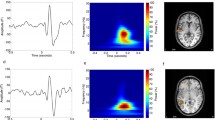Abstract
The hypothesis that the N1, the major negative component of the cortical evoked response to auditory stimuli, originates from the primary auditory cortex has been supported by several studies. In a previous study we showed that, when monaural stimulation with pure tones is used, the distribution of the N1 peak over the scalp could be accounted for by successive activation of adjacent sources on the floor of the Sylvian fissure. In an attempt to establish the generality of the phenomenon, in this study we investigated further the generation of the N1 component using a variety of auditory stimuli, including pure tones, complex sounds (musical notes), and words, as well as binaural stimulus presentation. Additionally, we used a new recording system which allows recording of the distribution of the magnetic flux over the entire head simultaneously, thus eliminating the need for multiple recording sessions and the related problems of habituation and of changes in attention level. We found that a series of single dipolar sources could account for the entire duration of the N1m component. The location of the sources fell within the primary auditory cortex and, during the evolution of the component, they followed a posterior-anterior, medial-lateral, superior-inferior trajectory, bilaterally, along the superior surface of the temporal lobes. Additionally, the distribution of N1 sources on the two hemispheres showed a marked asymmetry, with the right hemisphere sources covering a larger area. The established consistency of successive source excitation across subjects, studies, types of stimuli, and recording systems, as well as the newly demonstrated hemispheric asymmetry of source extent, suggest the presence of a reliable phenomenon indicative of the functional organization of the auditory cortex.
Similar content being viewed by others
References
DeLisi, L.E., Hoff, A.L., Neale, C., and Kushner, M. Assymetries in the superior temporal lobe in male and female first-episode schizophrenic patients: measures of the planum temporale and superior temporal gyrus by MRI. Schiz. Res., 1994, 12: 19–29.
Geschwind, N. and Galaburda, A.M. Cerebral lateralization: biological mechanisms, associations, and pathology: I. a hypothesis and a program fro research. Arch. Neurol., 1985, 42: 428–459.
Hari, R., Aittoniemi, M., Jarvinen, M.L., Katila, T. and Varpula, T. Auditory evoked transient and sustained magnetic fields of the human brain. Exp. Brain Res., 1980, 40: 237–240.
Hillyard, S.A. and Picton, T. The N1 wave of the human electric and magnetic response to sound: a review and analysis of the component structure. Psychophysiology, 1987, 24: 375–425.
Ide, A., Rodriguez, E., Zaidel, E., and Aboitiz, F. Bifurcation patterns in the human sylvian fissure: hemispheric and sex differences. Cerebral Cortex 1996, 6: 717–725.
Kobayashi, T., Kuriki, S., Takeuchi, F. A simulation study of dynamic characteristics of neuromagnetic fields using single-moving-dipole and two-fixed-dipoles models. Phys. Med. Biol., 1993, 38: 1271–1282.
Kuriki, S. Localization of cortical neuromagnetic sources of the auditory evoked responses to short speech sounds. Biomed. Res., 1992, Suppl. 1, 3: 39–43.
Kuriki, S., Okita, Y. and Hirata, Y. Source analysis of magnetic field responses from the human auditory cortex elicited by short speech sounds. Exp. Brain Res., 1995, 104: 144–152.
Lü, Z.L., Williamson, S.J. and Kaufman, L. Human auditory primary and association cortex have differeing lifetimes for activation traces. Brain Res., 1992, 572: 236–241.
Makela, JP., Hamalainen, M., Hari, R., and McEvoy, L. Wholehead mapping of middle-latency auditory evoked magnetic fields. Electroenceph. clin. Neurophysiol., 1994, 92: 414–421.
Moran, J.E., Tepley, N., Jacobson, G.P., Barkley, G.L. Evidence for multiple generators in evoked responses using finite difference field mapping: auditory fields. Brain Topography, 1993, 5: 229–240.
Okada, Y. Discrimination of localized and distributed current dipole sources and single and multiple sources. In: Weinberg H., Stroink G., Katila T. (Ed). Biomagnetism: application and theory. Pergamon, Oxford, 1985, pp. 266–272.
Pantev, C., Hoke, M., Lehnertz, K., Lutkenhoner, B., Fahrendorf G., Stober, U. Identification of sources of brain neuronal activity with high spatiotemporal resolution through combination of neuromagnetic source localization (NMSL) and magnetic resonance imaging (MRI). Electroenceph. clin. Neurophysiol., 1990, 75: 173–184.
Pantev, C., Bertrand, O., Eulitz, C., Verkindt, C., Hampson S., Schuierer, G., and Elbert, T. Specific tonotopic organization of different areas of the human auditory cortex revealed by simultaneous magnetic and electric recordings. Electroenceph. clin. Neurophysiol., 1995, 94: 26–40.
Papanicolaou, A.C., Baumann, S., Rogers, R.L., Saydjari, C., Amparo, E. and Eisenberg, H.M. Localization of auditory responses using MEG and MRI. Arch. Neurol., 1990, 47: 33–37.
Rogers, R.L., Papanicolaou, A.C., Baumann, S., Saydjari, C., and Eisenberg, H.M. Neuromagnetic evidence of a dynamic excitation pattern generating the N100 auditory response. Electroenceph. clin. Neurophysiol., 1990, 77: 237–240.
Singh, K.D., Ioannides, A.A., Gray, N., Kober, H., Pongratz, H., Daun, A. Grummich, P., Vieth, J. Distributed current analyses of bi-hemispheric magnetic N1m responses to ipsi/contralateral monaural stimuli from a single subject. Electroenceph. clin. Neurophysiol., 1994, 92: 365–368.
Witelson, S.F. and Kigar, D.L. Sylvian fissure morphology and asymmetry in men and women: bilateral differences in relation to handedness in men. J. Comp. Neurol., 1992, 323: 326–340.
Zimmermann, J.T., Reite, M. and Zimmermann, J.E. Magnetic auditory fields: dipole orientation, Electroenceph. clin. Neurophysiol., 1981, 52: 151–156.
Zouridakis, G., Simos, P.G., and Papanicolaou, A.C. Functional organization of the auditory cortex: evidence from wholehead MEG. Abstracts of the Fifteenth Annual Conference on Biomedical Engineering Research in Houston, 1997, p.46.
Author information
Authors and Affiliations
Corresponding author
Rights and permissions
About this article
Cite this article
Zouridakis, G., Simos, P.G. & Papanicolaou, A.C. Multiple Bilaterally Asymmetric Cortical Sources Account for the Auditory N1m Component. Brain Topogr 10, 183–189 (1998). https://doi.org/10.1023/A:1022246825461
Issue Date:
DOI: https://doi.org/10.1023/A:1022246825461




